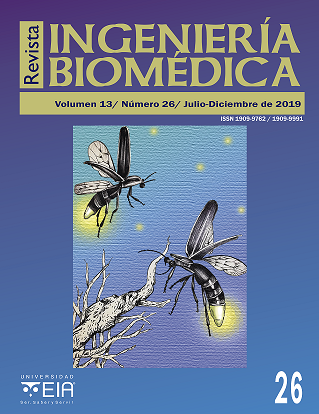Transposable Elements Insertion Polymorphisms Linked To Breast Cancer: A Proof Of Concept
Polimorfismos de inserción de elementos transponibles ligados a cancer de mama: una prueba de concepto

Show authors biography
Human endogenous retroviruses (HERVs) make up approximately 8% of the human genome, particularly overexpressed in some cells and tissues of breast carcinoma which is the most common and second leading cause of cancer death in women worldwide. Recent research shows that the HERV-K family of retroviruses is the most widely expressed family of genes in breast cancer. HERV-K elements 108, 109, 113, and 115 are the most found in this disease and are located at the genomic level on chromosome 6, 7, 8, and 19, respectively. The release of genomic data from patients pathologically identified with this disease has allowed advances in aspects of origin, development, and diagnosis. However, the treatment given to this information is done from biological approaches and with little computational contact (in silico). Thus, the following research at genomic scale is focused on finding new insertion polymorphisms that may be linked to breast cancer, through TRACKPOSON, a software designed for the detection of transposable element insertion polymorphisms (TIPs). This pipeline was used in 3,000 rice genomes, but its functionality was extrapolated to this project using the reference human genome, a database of HERVs and genome sequencing reads of case (breast cancer) and control (disease-free) patients that were obtained using Illumina technology. Finally, the results obtained in silico show TIPs associated with breast cancer with its chromosomal location, so this "bioinformatic mimicry" could offer improvement in the research methods and diagnostic approach of this disease.
Article visits 1119 | PDF visits 698
Downloads
- O. Ridge, J. Genetics, L. Cells, J. Reed, M. Lefort, y E. Sgourakis, “(or recognition)”, 1950.
- G. Bourque et al., “Ten things you should know about transposable elements”, pp. 1–12, 2018.
- R. P. Subramanian, J. H. Wildschutte, C. Russo, y J. M. Coffin, “Identification , characterization , and comparative genomic distribution of the HERV-K ( HML-2 ) group of human endogenous retroviruses”, pp. 1–22, 2011.
- E. R. Havecker, X. Gao, y D. F. Voytas, “The diversity of LTR retrotransposons”, 2004.
- M. Zhang y J. Q. Liang, “Expressional activation and functional roles of human endogenous retroviruses in cancers”, núm. November 2018, pp. 1–11, 2019.
- A. Roesch, E. Meese, J. Mayer, y K. Schmitt, “Transcriptional Profiling of Human Endogenous Retrovirus Group HERV-K ( HML-2 ) Loci in Melanoma”, vol. 5, núm. 2, pp. 307–328, 2013.
- W. Goering, K. Schmitt, M. Dostert, H. Schaal, J. Mayer, y W. A. Schulz, “Human Endogenous Retrovirus HERV-K ( HML-2 ) Activity in Prostate Cancer Is Dominated by a Few Loci”, vol. 1971, núm. September, pp. 1958–1971, 2015.
- M. Li et al., “Downregulation of Human Endogenous Retrovirus Type K ( HERV-K ) Viral env RNA in Pancreatic Cancer Cells Decreases Cell Proliferation and Tumor Growth”, vol. 23, núm. 43, 2017.
- G. L. Johanning, G. G. Malouf, X. Zheng, y F. J. Esteva, “Expression of human endogenous retrovirus-K is strongly associated with the basal-like breast cancer phenotype”, Nat. Publ. Gr., núm. August 2016, pp. 1–11, 2017.
- L. Cegolon, C. Salata, E. Weiderpass, P. Vineis, G. Palù, y G. Mastrangelo, “Human endogenous retroviruses and cancer prevention : evidence and prospects”, 2013.
- C. E. Desantis, “Breast Cancer Statistics , 2017 , Racial Disparity in Mortality by State”, vol. 67, núm. 6, pp. 439–448, 2017.
- E. Hénaff, L. Zapata, J. M. Casacuberta, y S. Ossowski, “Jitterbug : somatic and germline transposon insertion detection at single-nucleotide resolution”, BMC Genomics, pp. 1–16, 2015.
- M. Carpentier et al., “Retrotranspositional landscape of Asian rice revealed by 3000 genomes”, Nat. Commun., núm. 2019.
- N. Bannert, H. Hofmann, A. Block, y O. Hohn, “HERVs New Role in Cancer : From Accused Perpetrators to Cheerful Protectors”, vol. 9, núm. February, pp. 1–8, 2018.
- X. Chen, “Understanding the genetic architecture of schizophrenia in Chinese population”.
- B. Langmead y S. L. Salzberg, “Fast gapped-read alignment with Bowtie 2”, vol. 9, núm. 4, pp. 357–360, 2012.
- H. Li et al., “The Sequence Alignment / Map format and SAMtools”, vol. 25, núm. 16, pp. 2078–2079, 2009.
- A. R. Quinlan y I. M. Hall, “BEDTools : a flexible suite of utilities for comparing genomic features”, vol. 26, núm. 6, pp. 841–842, 2010.
- S. F. Altschup, W. Gish, T. Pennsylvania, y U. Park, “Basic Local Alignment Search Tool 2Department of Computer Science”, pp. 403–410, 1990.
- R. Contreras-galindo et al., “Human Endogenous Retrovirus K ( HML-2 ) Elements in the Plasma of People with Lymphoma and Breast Cancer ᰔ †”, vol. 82, núm. 19, pp. 9329–9336, 2008.
- K. Ruprecht et al., “Human Endogenous Retrovirus Family HERV-K ( HML-2 ) RNA Transcripts Are Selectively Packaged into Retroviral Particles Produced by the Human Germ Cell Tumor Line Tera-1 and Originate Mainly from a Provirus on Chromosome 22q11 . 21 ᰔ †”, vol. 82, núm. 20, pp. 10008–10016, 2008.




